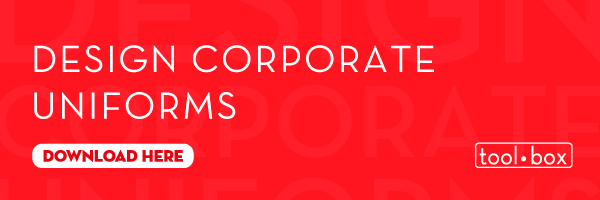First impressions count. Clients form their opinion about your brand based on their first interaction. A corporate uniform or dress code plays a vital role in these impressions, as it can motivate your team members to connect with your brand’s mission and vision. Designing a company uniform requires strategic planning, considering the brand’s purpose and objectives. Additionally, the uniform should reflect the changing market, inspire confidence, and convey a contemporary feel.

Like any element of brand and marketing, uniform design and implementation need to be well thought out and planned.
Read on to find out everything you need to know in order to create a corporate uniform policy and learn how to design the right corporate uniform for your brand.
Tips to Create a Corporate Uniform Policy
While corporate uniforms might be necessary for your brand’s consistency, for your brand’s consistency, it is crucial to also create a corporate uniform policy that includes everyone at your organisation and ensures compliance and effectivity. To achieve this, consider the following tips to ensure your uniform policy is fair both towards your brand’s identity and mission, and your employees’ need to feel appreciated and comfortable.
First, Why Do You Need a Uniform Policy?
Explain Expectations

To avoid misunderstandings, make it crystal clear what you mean by terms like “formal”, “casual”, etc. Provide clear guidelines about what is acceptable and what isn’t. These expectations should be applied to everyone from employees and senior management to interns and even temps, creating a sense of harmony and belonging for all.
Make it Easy for New Starters and Ensure Safety

Part of your employee onboarding checklist should include a clear uniform policy that helps starters fit in and feel part of the team from day one. Take this worry out of their minds and ensure they’ll keep your brand’s image intact from the get-go. Considere including the policy in welcome packs for new employees. Some jobs require employees to wear certain types of uniforms due to health and safety regulations. Taking this into consideration further ensures safety and makes it easier to control these risk factors.
Ensure Consistency and Get Fewer Complaints

Consistency is key to any brand that wants to transmit an identity consistently to its audience. Corporate uniforms further this message at every level of contact. By having a clear uniform policy, complaints about “inappropriate” dress practices will drop dramatically, and there will be more harmony among all employees. Legal actions from disgruntled employees will also diminish when your uniform policy is clear.
So, How Do You Create a Corporate Uniform Policy?
1. Include All Your Employees

When developing your corporate uniform policy, be as inclusive as possible. Think about each different division or department within your company and consider all their different needs and expectations. To do this, include representation and gather opinions from your entire organisation. This process will help you to not overlook different needs you didn’t think of. It will also make everyone feel part of the process, making them more likely to comply with the policy with pride. Be sure to represent all job types when developing uniforms. Keep in mind that workers who perform a more physical type of job, such as those who operate machinery, for example, will have different needs from those working a desk job or customer service.
2. Communicate Clearly

Make double sure to clearly explain all your decisions and policies to your employees in a way they’ll understand and feel included and appreciated. Regularly ask for their input and allow suggestions to make them feel included and connected to the brand. This also foments constant improvement.
It’s important to also include a discipline system in your policy. This system should be applied fairly and consistently across the entire organisation.
Include a clear outline of what disciplinary options will be applied. These can range from administrative warnings to requiring the employee to go home and change, to more severe actions like termination. All depending on the severity and repetitiveness of the violations.
3. Address Dress-Code Violation Issues Delicately

If you consider an employee has violated the uniform policy, take the time to make sure a violation has actually taken place and gather proof before taking action. Once it has been established that a dress-code violation has taken place, have a manager speak to the employee in a discreet way, maintaining a level of confidentiality and ensuring the employee understands what the violation was.
When applying a warning or disciplinary action, stick to the facts and avoid getting into personal details or judgment calls. It’s important to find out why the employee incurred in the dress-code violation.
As a general rule, when creating a uniform policy, be fair, communicate clearly and often, and include your employees in your decisions. These best practices will create a policy that benefits both your brand and your employees.
Awesome Uniform Design Guide [workbook]
Develop the look and feel of your corporate uniforms at the same time you develop your corporate uniform policy to ensure both processes feed off of each other. Keep your brand’s identity and employee appreciation and input working together to get a final product that will satisfy everyone’s needs.
Download this Corporate Uniforms Design Guide to help you go through the process smoothly and create a set of uniform items that’ll make your employees look brand-tastic.
Get started with your staff and employees, and get in touch with us to develop a set of uniform items that fit perfectly within your policy, budget, objectives, promotional marketing scope, and employee expectations.


